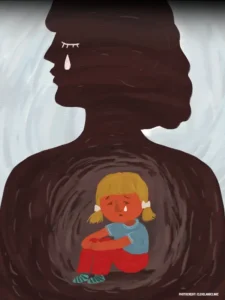Discover the definition and impact of childhood trauma. Explore the signs, symptoms, and treatment options for this complex issue.
What is Childhood Trauma:
Childhood trauma is a distressing experience or event that a child goes through, leaving a lasting impact on their emotional and psychological well-being. It encompasses a wide range of adverse childhood experiences that can profoundly affect a child’s development and overall quality of life.
Childhood trauma refers to any adverse experience or event that poses a threat to a child’s physical or emotional safety. These experiences often occur during sensitive developmental stages and can have long-term consequences if left unaddressed.
Parents can create a safe and supportive environment, validate their child’s feelings,
Common Types of Childhood Trauma:
Childhood trauma can take on various forms, each with its distinct characteristics and consequences. Some prevalent types of childhood trauma include.
Physical Abuse: This involves the deliberate infliction of physical harm or injury upon a child by a caregiver or authority figure. Examples include hitting, punching, kicking, burning, or any other violent act causing physical harm.
Emotional Abuse: Emotional abuse refers to the ongoing emotional maltreatment or verbal aggression directed at a child, undermining their self-worth and emotional well-being. Examples include constant criticism, humiliation, rejection, and threats of harm.
Sexual Abuse: Sexual abuse encompasses any form of sexual activity imposed on a child without their consent. This can include molestation, rape, incest, sexual exploitation, or exposure to sexually explicit material.
Neglect: Neglect occurs when caregivers fail to provide adequate care, supervision, or emotional support for a child’s basic needs. This may include insufficient food, shelter, clothing, medical care, or emotional nurturing.
Witnessing Domestic Violence: Children who witness domestic violence between their parents or caregivers experience trauma from exposure to physical, verbal, or emotional abuse. Witnessing violence at home can have enduring effects on a child’s emotional and psychological well-being.
Community Violence: Exposure to violence in the community, such as crime, gang activity, or shootings, can traumatize children, instilling feelings of fear, helplessness, and insecurity.
Natural Disasters: Children experiencing natural disasters like earthquakes, hurricanes, floods, or wildfires may suffer trauma due to loss of homes, possessions, or loved ones, as well as disruption of their daily lives.
Bullying: Persistent bullying or harassment at school or in the community can cause significant emotional distress and trauma for children. Bullying may manifest physically, verbally, relationally, or through cyber means.
Medical Trauma: Serious illness, injury, or medical procedures can be traumatic for children, particularly if they involve painful treatments, hospitalizations, or invasive procedures. Medical trauma can induce feelings of fear, anxiety, and helplessness.
Parental Substance Abuse: Children of parents who abuse drugs or alcohol may experience neglect, emotional abuse, or exposure to perilous situations, leading to trauma and long-term emotional difficulties.

Causes of Childhood Trauma:
Childhood trauma can arise from various sources, each with its unique challenges and repercussions.
Family Dysfunction: Dysfunction within the family environment, such as parental conflict, substance abuse, domestic violence, or mental illness, can expose children to traumatic experiences.
Abuse (Physical, Emotional, Sexual): Physical abuse involves the infliction of physical harm or injury on a child by a caregiver, while emotional abuse refers to persistent emotional maltreatment or rejection that undermines a child’s self-worth. Sexual abuse involves any form of sexual activity imposed on a child without their consent.
Neglect: Neglect occurs when caregivers fail to provide adequate care, supervision, or emotional support for a child’s basic needs, including food, shelter, and affection.
Natural Disasters: Exposure to natural disasters such as earthquakes, hurricanes, floods, or wildfires can result in traumatic experiences for children, leading to feelings of fear, helplessness, and loss.
Community Violence: Living in neighborhoods plagued by crime, gang activity, or community violence can expose children to traumatic events, leading to feelings of insecurity and fear.
Medical Trauma: Serious illness, injury, or medical procedures can be traumatic for children, especially if they involve painful treatments, hospitalizations, or invasive procedures.
Accidents or Injuries: Traumatic events such as car accidents, falls, or injuries can have a significant impact on children, causing physical and emotional distress.
Bullying: Persistent bullying or harassment at school or in the community can traumatize children, leading to feelings of shame, fear, and isolation.
War or Conflict: Children living in areas affected by war, armed conflict, or political instability may experience traumatic events such as bombings, displacement, or loss of loved ones.
Parental Separation or Divorce: The breakup of a family through separation or divorce can be traumatic for children, leading to feelings of abandonment, confusion, and grief.
Effects of Childhood Trauma:
Childhood trauma can have profound and enduring effects on an individual’s physical, emotional, and psychological well-being. Here are some of the common consequences associated with childhood trauma.
Physical Health Effects: Children who experience trauma may be at a higher risk of developing chronic health conditions later in life, such as heart disease, diabetes, obesity, and autoimmune disorders. The prolonged stress response triggered by trauma can weaken the immune system, making individuals more susceptible to physical illnesses.
Mental Health Effects: Childhood trauma is strongly linked to the development of mental health disorders, including post-traumatic stress disorder (PTSD), depression, anxiety disorders, and substance abuse. Trauma can disrupt normal brain development and impair cognitive functions, leading to difficulties in concentration, memory, and problem-solving.
Emotional Effects: Traumatized children often struggle to regulate their emotions, experiencing intense feelings of fear, anger, sadness, or emotional numbness. Building and maintaining healthy relationships may be challenging, and they may exhibit symptoms of emotional dysregulation such as mood swings or outbursts.
Behavioral Effects: Children coping with trauma may display various maladaptive behaviors as coping mechanisms, including aggression, self-harm, substance abuse, risky sexual behavior, or running away from home. They may also struggle with impulsivity, hyperactivity, and difficulty in controlling their impulses.
Social Effects: Childhood trauma can impede social development and interpersonal relationships. Trust issues may arise, along with difficulties in forming attachments and social withdrawal from peers and family. Feelings of loneliness, alienation, and isolation are common among traumatized individuals.
Academic Effects: Trauma can disrupt learning and academic success. Children who have experienced trauma may struggle with concentration, completing tasks, and participating in school activities. Disruptive behavior and frequent absences may also be observed in this population.
Self-esteem and Identity: Childhood trauma can significantly impact self-esteem and identity formation. Negative beliefs about oneself, and feelings of shame, guilt, or worthlessness may develop as a result of the traumatic experience. Confidence may diminish, making it challenging for individuals to envision a positive future for themselves.
Symptoms of Childhood Trauma:
Recognizing the signs and symptoms of childhood trauma is essential for early intervention and support. Common indicators include:
- Sleeping too much or too little
- Depression
- Constantly being “on guard”
- Being easily startled
- Loss of interest in activities they once liked
- Detachment/Lack of responsiveness
- Trouble with affection
- Irritable and possibly violent
- Emotional Distress: Persistent sadness, anxiety, anger, or irritability.
- Behavioral Changes: Withdrawal from activities, aggression, self-harm, or substance abuse.
- Physical Symptoms: Headaches, stomachaches, insomnia, or other unexplained physical complaints.
Treatment Of Childhood Trauma:
Treating childhood trauma demands a thorough and diverse approach, targeting its physical, emotional, and psychological repercussions. Here are the essential components of effective treatment.
- Cognitive-behavioral therapy (CBT) assists children in recognizing and challenging negative thought patterns and behaviors linked to trauma.
- Play therapy enables children to articulate themselves through play, aiding in processing their emotions and experiences within a secure setting.
- According to Kaslow, the chief psychologist at Grady Memorial Hospital in Atlanta and recipient of a 2006 APA Presidential Citation for her efforts in assisting psychology trainees, postdoctoral fellows, and training sites following Hurricane Katrina, “Psychological difficulties often emerge in response to interpersonal challenges. It’s gratifying to witness individuals considering their circumstances, broader context, and systemic factors.”
Therapeutic Interventions: Psychotherapy forms the foundation of childhood trauma treatment. Utilizing evidence-based methods like cognitive-behavioral therapy (CBT), trauma-focused cognitive behavioral therapy (TF-CBT), and eye movement desensitization and reprocessing (EMDR), therapists aid children in processing their traumatic experiences, managing distressing symptoms, and developing coping mechanisms.
Play Therapy: Offering a secure and non-threatening space, play therapy allows children to express themselves and delve into their emotions. Through imaginative play activities, children can articulate their experiences, handle emotions, and address trauma-related issues under the guidance of a skilled therapist.
Family Therapy: Involving the child’s family is vital for healing. Family therapy enhances communication, fortifies familial bonds, and tackles dysfunctional patterns contributing to ongoing stress and trauma. It equips parents and caregivers with tools to support their child’s recovery and foster a nurturing family environment.
Medication: In certain cases, medication may be prescribed to alleviate symptoms of trauma-related conditions like depression, anxiety, or sleep disturbances. Psychiatrists may recommend antidepressants or anti-anxiety medications alongside psychotherapy to relieve distressing symptoms and enhance overall functioning.
Supportive Services: Access to support services and resources is critical for affected children and families. These encompass case management, crisis intervention, support groups, and community-based programs designed to offer practical aid, emotional support, and connections to additional resources.
Education and Psychoeducation: Providing education and psychoeducation about trauma enables children and families to comprehend their experiences, normalize reactions, and acquire effective coping strategies. Psychoeducation may include teaching relaxation techniques, stress management skills, and methods for self-care and emotional regulation.
Culturally Competent Care: Recognizing and respecting cultural diversity is crucial in delivering effective trauma treatment. Culturally competent care acknowledges the influence of cultural beliefs, values, and practices on trauma experiences and ensures treatment approaches are sensitive, inclusive, and tailored to meet the cultural needs and preferences of the child and family.
Continued Monitoring and Support: Recovery from childhood trauma is an ongoing process requiring consistent monitoring and support. Regular check-ins with mental health professionals, follow-up appointments, and access to ongoing support services aid children and families in navigating challenges, tracking progress, and preserving overall well-being over time.
Diagnosis Of Childhood Trauma:
Pervasive Developmental Disorders (PDDs): entail more severe challenges with reality orientation, communication, and stereotypic behaviors compared to attachment and information processing issues seen in children, as noted by Ford. Unlike Developmental Trauma Disorder (DTD), PDDs typically lack pronounced anxiety and depressed mood.
Oppositional Defiant Disorder (ODD): and Conduct Disorder (CD) exhibit intense anger, distrust, and relational conflicts similar to DTD. However, they do not encompass the guilt, shame, anxiety, dissociation, and depressed mood prevalent in children with DTD.
Reactive Attachment Disorder (RAD): shares symptoms and impairments with DTD but is confined to early childhood and must occur within a context of “pathogenic care,” such as neglect or abandonment. In contrast, children with DTD may experience trauma without facing neglect or abandonment.
Affective disorders: Aspects of DTD, such as sadness, loss of interest, and social withdrawal, according to Ford. However, they do not encompass DTD-related anxiety, reactive anger, shame, guilt, dissociation, and disorganized feelings about trust and relationships.
Anxiety disorders: capture fearfulness and avoidance, resembling aspects of DTD. Yet, they do not encompass the intensely changeable emotional states, negative self-beliefs, and disorganized attachment behaviors characteristic of DTD.
Borderline personality disorder (BPD): mirrors the changeable emotional states and disturbed relationships associated with DTD-related dysregulation and attachment issues. However, BPD is an adult diagnosis unsuitable for children whose personalities are still developing. Additionally, it does not address children’s dissociation, physical complaints, or extreme dysregulation in response to trauma reminders or memories, Ford explains.

Case Studies and Real-Life Examples:
Emma’s Story: Overcoming Adversity
– Emma grew up in a household marked by domestic violence and substance abuse. From a young age, she witnessed her parents’ volatile arguments and experienced neglect. Emma struggled academically and socially, displaying signs of anxiety and depression.
– However, with the support of a dedicated therapist and access to trauma-focused therapy, Emma began to heal. Through counseling and participation in support groups, she learned coping strategies to manage her emotions and build healthy relationships. Today, Emma is a passionate advocate for survivors of childhood trauma, using her journey as inspiration to empower others.
Juan’s Journey: Breaking the Cycle of Abuse
– Juan’s childhood was marred by physical and emotional abuse at the hands of his alcoholic father. Growing up in fear, Juan struggled with anger issues and developed a sense of worthlessness. As a teenager, he became involved in delinquent behavior and substance abuse as a means of coping with his trauma.
– However, with the intervention of a caring mentor and access to counseling services, Juan began to confront his past and rebuild his life. Through therapy and participation in rehabilitation programs, he learned to channel his emotions constructively and break free from the cycle of abuse. Today, Juan is a dedicated father and mentor, using his experiences to support other survivors on their journey to healing.
Sarah’s Struggle: Navigating Complex Trauma
– Sarah experienced multiple forms of trauma throughout her childhood, including sexual abuse by a family member and witnessing her mother’s struggle with mental illness. As a result, Sarah battled with feelings of shame, guilt, and low self-esteem.
– Despite her challenges, Sarah found solace in art therapy and expressive writing, using creative outlets to process her emotions and reclaim her sense of identity. With the guidance of a trauma-informed therapist, Sarah embarked on a journey of self-discovery and healing. Through resilience and determination, she learned to confront her past trauma and cultivate a sense of empowerment. Today, Sarah uses her voice to advocate for survivors of childhood trauma, sharing her story as a beacon of hope for others on their path to recovery.
FAQ
Most frequent questions and answers
Encouraging open communication, promoting healthy coping strategies such as mindfulness or relaxation techniques, and seeking professional support from therapists or counselors can help children cope with trauma.
Parents can create a safe and supportive environment, validate their child’s feelings, and seek appropriate mental health services to help their child process and recover from trauma.
Not always. Some children may internalize their distress and exhibit few outward signs of trauma, making it essential for caregivers and educators to be vigilant and responsive to subtle changes in behavior or emotional well-being.
Conclusion:
Childhood trauma is a significant public health concern that can have far-reaching consequences for individuals and society as a whole. By raising awareness, providing support, and implementing evidence-based interventions, we can help children heal and thrive despite their adverse experiences.









